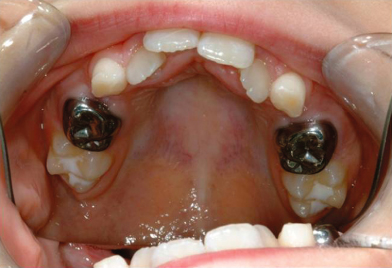26
Space Maintenance
Space Management
Common orthodontic problems stem from crowding and the lack of space available for the permanent dentition to erupt. Usually the problem arises due to premature loss of the deciduous teeth from trauma, caries or pulp pathology (Fig. 26.1). Maintaining space is important and every effort should be made to preserve the primary teeth to prevent problems in the developing dentition such as space loss. However, space maintainers are not required every time a primary molar is lost prematurely. The decision to fit a space maintainer after enforced extraction must be arrived at by balancing the occlusal disturbance that may result against the plaque accumulation and caries that the appliance may cause and poor oral hygiene, which is a contraindication. A decision to fit a space maintainer should be made only after a careful assessment of the developing occlusion and its predicted patterns and the patient factors such as behaviour, compliance and oral hygiene.
Figure 26.1 Space loss due to premature extraction of both upper first primary molars.

Common Causes of Space Loss in Primary and Mixed Dentition
- Premature loss of primary teeth.
- Congenitally missing teeth.
- Unrestored proximal carious lesions.
- Ectopic eruption or permanent teeth.
- Ankylosis.
- Dental anomalies particularly microdontia (e.g. peg-shaped laterals).
Indications for Space Maintainers
These are most useful in two situations:
- Loss of a primary first molar where crowding is severe, i.e. more than 3.5 mm (half a unit) per quadrant. In this situation space loss due to drift may be so severe that the extraction of one premolar may be insufficient to relieve resultant crowding so that subsequent orthodontic treatment is more difficult.
- Loss of a primary second molar, except in spaced arches.
Other indications are:
- loss of permanent upper incisors;
- delayed eruption of permanent central incisors due t/>
Stay updated, free dental videos. Join our Telegram channel

VIDEdental - Online dental courses


